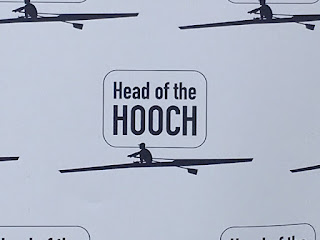Chattanooga is abuzz with activity on the riverfront as preparations are being made for its annual "Head of the Hooch" rowing regatta (Where are you, my rowing friend, Joan Abe?). The Head of the Hooch is one of the world's largest rowing regattas; more than 2,000 boats will be rowing/racing on a 3.1 mile stretch on the Tennessee River tomorrow (Saturday) and Sunday. The regatta began in 1982 on the Chattahooch River in Georgia, (thus, the "Hooch"). Because of its growth in popularity, the location was moved in 2005 to the more accommodating Chattanooga. Participants are here from all over the country (including rowing clubs with impressive names....Berkley, Vanderbilt, Baylor, William and Mary, Duke; and some with interesting names....Chinook Performance Racing, Beaver Creek Sculling, Club Nautico De San Juan). Fit and focused young athletes are all over the place. As I took a break from "boat projects" to walk and explore, I was awed amidst the the city's vibrancy as I learned more about its history.
The Walnut Street Bridge was built in 1890 and today is one of the longest pedestrian bridges in the world. The plagues along the bridge tell of Chattanooga's history and one cannot help but be affected by the struggles this area has gone through to get to where it is today:
Early Americans and their quest for land brought about a treaty with the Native American Nations (including Cherokee). While most Natives weren't for the treaty, the offer was too good for the Native Nations reps to refuse. The result was the forced march "Trail of Tears" of the Native American people to the west of the Mississippi. On a downtown plaque, it is written that this period is one of the saddest in Tennessee's history.
The Tennessee River was an important transportation waterway, but also dangerous and sometimes impassable due to extreme water levels. While dams were developed by private corporations to improve this, President FDR established the Tennessee Valley Authority and the government took over to create a reliable waterway and electricity, jobs and economic opportunities. The enormity of the TVA can be felt by walking past its headquarters located in a massive building in Chattanooga.
When the Civil War conflict began, Tennessee was the last to declare secession from the Union and go to the side of the Confederates. When the Civil War ended, Tennessee was the first Confederate state to rejoin the Union. Skirmishes and major Civil War battles were fought in every single county of Tennessee. The struggles in ideology literally pit brother against brother, neighbor against neighbor. How difficult it must have been to forgive, reconcile, and move forward.
Chattanooga was once thought to be a faded industrial town on the Tennessee River burdened with empty factories, a deteriorating downtown, sprawling suburbs, and the worst air quality of any U.S. city. Today, I breathed in clean and fresh air, admired statues and art along walkways, heard noises associated with new construction, considered the livability of the place, and pondered on how the leaders of Chattanooga are working to rebuild the downtown, connect the city's historic riverfront with new businesses, and attract and welcome tourists. How proud they must feel of their efforts as rowers, coaches, family members, vendors, tourists and citizens line the riverfront this weekend to compete in the fierce and friendly "Head of the Hooch" competition.
 |
| This is along the waterfront, near the Tennessee Aquarium. Each rowing team seems to have their own space with a tent. |
 |
| This street is closed and the parking lot is one of several lots of trailers loaded with sculls for the competition. |
 |
| Athletes and others are getting equipment together in preparation for today's practices and this weekend's races. |
 |
| The logo for the event. |
 |
| Outside the Aquarium was a group of 7th graders being arranged for a group photo. Their matching shirts indicated this was their "7th Grade Field Trip." |
 |
| And then there are the vendors for the event.....looking forward to walking through them this weekend! |
 |
| This is the Walnut Street Bridge. When it was first built, it was the first permanent structure to link the north and south sides of the Tennessee River. While it once held all kinds of traffic, today it is a bridge for pedestrians and bicyclists. |
 |
| This is the Tennessee Valley Authority building downtown Chattanooga. I don't know how many blocks it takes up. |
 |
| This is a memorial to the "Trail of Tears." Walking along side it stirs up emotions for the tragedy of the forced evacuation. |
 |
| Along the wall are Native American symbols; their meanings are described on plaques within the steps. |
 |
| Art in Chattanooga--along the sidewalks, walking and bike paths--is plentiful, and each are beautiful and noteworthy. You can also see that we are nearing the peak of fall colors in the area by the bright red of the nearby maple trees. |
 |
| Doesn't this inspire you to want to grab his paw and shake his hand? |














Comments
Post a Comment
We would love to hear your comments!